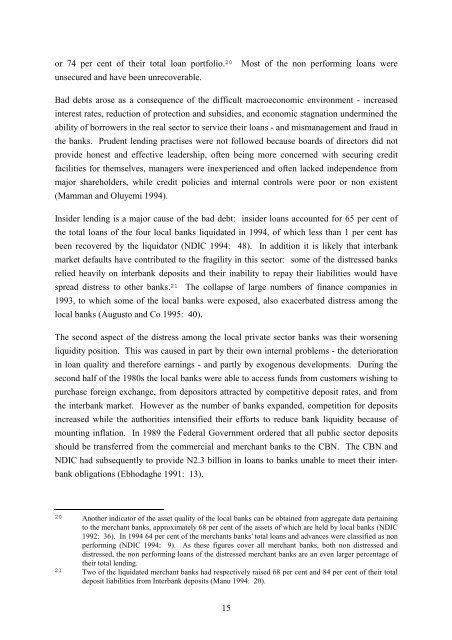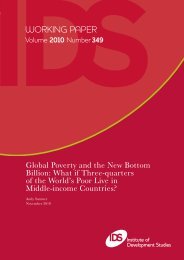the impact of public policy on the banking system in nigeria
the impact of public policy on the banking system in nigeria
the impact of public policy on the banking system in nigeria
You also want an ePaper? Increase the reach of your titles
YUMPU automatically turns print PDFs into web optimized ePapers that Google loves.
or 74 per cent <str<strong>on</strong>g>of</str<strong>on</strong>g> <str<strong>on</strong>g>the</str<strong>on</strong>g>ir total loan portfolio. 20 Most <str<strong>on</strong>g>of</str<strong>on</strong>g> <str<strong>on</strong>g>the</str<strong>on</strong>g> n<strong>on</strong> perform<strong>in</strong>g loans were<br />
unsecured and have been unrecoverable.<br />
Bad debts arose as a c<strong>on</strong>sequence <str<strong>on</strong>g>of</str<strong>on</strong>g> <str<strong>on</strong>g>the</str<strong>on</strong>g> difficult macroec<strong>on</strong>omic envir<strong>on</strong>ment - <strong>in</strong>creased<br />
<strong>in</strong>terest rates, reducti<strong>on</strong> <str<strong>on</strong>g>of</str<strong>on</strong>g> protecti<strong>on</strong> and subsidies, and ec<strong>on</strong>omic stagnati<strong>on</strong> underm<strong>in</strong>ed <str<strong>on</strong>g>the</str<strong>on</strong>g><br />
ability <str<strong>on</strong>g>of</str<strong>on</strong>g> borrowers <strong>in</strong> <str<strong>on</strong>g>the</str<strong>on</strong>g> real sector to service <str<strong>on</strong>g>the</str<strong>on</strong>g>ir loans - and mismanagement and fraud <strong>in</strong><br />
<str<strong>on</strong>g>the</str<strong>on</strong>g> banks. Prudent lend<strong>in</strong>g practises were not followed because boards <str<strong>on</strong>g>of</str<strong>on</strong>g> directors did not<br />
provide h<strong>on</strong>est and effective leadership, <str<strong>on</strong>g>of</str<strong>on</strong>g>ten be<strong>in</strong>g more c<strong>on</strong>cerned with secur<strong>in</strong>g credit<br />
facilities for <str<strong>on</strong>g>the</str<strong>on</strong>g>mselves, managers were <strong>in</strong>experienced and <str<strong>on</strong>g>of</str<strong>on</strong>g>ten lacked <strong>in</strong>dependence from<br />
major shareholders, while credit policies and <strong>in</strong>ternal c<strong>on</strong>trols were poor or n<strong>on</strong> existent<br />
(Mamman and Oluyemi 1994).<br />
Insider lend<strong>in</strong>g is a major cause <str<strong>on</strong>g>of</str<strong>on</strong>g> <str<strong>on</strong>g>the</str<strong>on</strong>g> bad debt: <strong>in</strong>sider loans accounted for 65 per cent <str<strong>on</strong>g>of</str<strong>on</strong>g><br />
<str<strong>on</strong>g>the</str<strong>on</strong>g> total loans <str<strong>on</strong>g>of</str<strong>on</strong>g> <str<strong>on</strong>g>the</str<strong>on</strong>g> four local banks liquidated <strong>in</strong> 1994, <str<strong>on</strong>g>of</str<strong>on</strong>g> which less than 1 per cent has<br />
been recovered by <str<strong>on</strong>g>the</str<strong>on</strong>g> liquidator (NDIC 1994: 48). In additi<strong>on</strong> it is likely that <strong>in</strong>terbank<br />
market defaults have c<strong>on</strong>tributed to <str<strong>on</strong>g>the</str<strong>on</strong>g> fragility <strong>in</strong> this sector: some <str<strong>on</strong>g>of</str<strong>on</strong>g> <str<strong>on</strong>g>the</str<strong>on</strong>g> distressed banks<br />
relied heavily <strong>on</strong> <strong>in</strong>terbank deposits and <str<strong>on</strong>g>the</str<strong>on</strong>g>ir <strong>in</strong>ability to repay <str<strong>on</strong>g>the</str<strong>on</strong>g>ir liabilities would have<br />
spread distress to o<str<strong>on</strong>g>the</str<strong>on</strong>g>r banks. 21 The collapse <str<strong>on</strong>g>of</str<strong>on</strong>g> large numbers <str<strong>on</strong>g>of</str<strong>on</strong>g> f<strong>in</strong>ance companies <strong>in</strong><br />
1993, to which some <str<strong>on</strong>g>of</str<strong>on</strong>g> <str<strong>on</strong>g>the</str<strong>on</strong>g> local banks were exposed, also exacerbated distress am<strong>on</strong>g <str<strong>on</strong>g>the</str<strong>on</strong>g><br />
local banks (Augusto and Co 1995: 40).<br />
The sec<strong>on</strong>d aspect <str<strong>on</strong>g>of</str<strong>on</strong>g> <str<strong>on</strong>g>the</str<strong>on</strong>g> distress am<strong>on</strong>g <str<strong>on</strong>g>the</str<strong>on</strong>g> local private sector banks was <str<strong>on</strong>g>the</str<strong>on</strong>g>ir worsen<strong>in</strong>g<br />
liquidity positi<strong>on</strong>. This was caused <strong>in</strong> part by <str<strong>on</strong>g>the</str<strong>on</strong>g>ir own <strong>in</strong>ternal problems - <str<strong>on</strong>g>the</str<strong>on</strong>g> deteriorati<strong>on</strong><br />
<strong>in</strong> loan quality and <str<strong>on</strong>g>the</str<strong>on</strong>g>refore earn<strong>in</strong>gs - and partly by exogenous developments. Dur<strong>in</strong>g <str<strong>on</strong>g>the</str<strong>on</strong>g><br />
sec<strong>on</strong>d half <str<strong>on</strong>g>of</str<strong>on</strong>g> <str<strong>on</strong>g>the</str<strong>on</strong>g> 1980s <str<strong>on</strong>g>the</str<strong>on</strong>g> local banks were able to access funds from customers wish<strong>in</strong>g to<br />
purchase foreign exchange, from depositors attracted by competitive deposit rates, and from<br />
<str<strong>on</strong>g>the</str<strong>on</strong>g> <strong>in</strong>terbank market. However as <str<strong>on</strong>g>the</str<strong>on</strong>g> number <str<strong>on</strong>g>of</str<strong>on</strong>g> banks expanded, competiti<strong>on</strong> for deposits<br />
<strong>in</strong>creased while <str<strong>on</strong>g>the</str<strong>on</strong>g> authorities <strong>in</strong>tensified <str<strong>on</strong>g>the</str<strong>on</strong>g>ir efforts to reduce bank liquidity because <str<strong>on</strong>g>of</str<strong>on</strong>g><br />
mount<strong>in</strong>g <strong>in</strong>flati<strong>on</strong>. In 1989 <str<strong>on</strong>g>the</str<strong>on</strong>g> Federal Government ordered that all <str<strong>on</strong>g>public</str<strong>on</strong>g> sector deposits<br />
should be transferred from <str<strong>on</strong>g>the</str<strong>on</strong>g> commercial and merchant banks to <str<strong>on</strong>g>the</str<strong>on</strong>g> CBN. The CBN and<br />
NDIC had subsequently to provide N2.3 billi<strong>on</strong> <strong>in</strong> loans to banks unable to meet <str<strong>on</strong>g>the</str<strong>on</strong>g>ir <strong>in</strong>terbank<br />
obligati<strong>on</strong>s (Ebhodaghe 1991: 13).<br />
20 Ano<str<strong>on</strong>g>the</str<strong>on</strong>g>r <strong>in</strong>dicator <str<strong>on</strong>g>of</str<strong>on</strong>g> <str<strong>on</strong>g>the</str<strong>on</strong>g> asset quality <str<strong>on</strong>g>of</str<strong>on</strong>g> <str<strong>on</strong>g>the</str<strong>on</strong>g> local banks can be obta<strong>in</strong>ed from aggregate data perta<strong>in</strong><strong>in</strong>g<br />
to <str<strong>on</strong>g>the</str<strong>on</strong>g> merchant banks, approximately 68 per cent <str<strong>on</strong>g>of</str<strong>on</strong>g> <str<strong>on</strong>g>the</str<strong>on</strong>g> assets <str<strong>on</strong>g>of</str<strong>on</strong>g> which are held by local banks (NDIC<br />
1992: 36). In 1994 64 per cent <str<strong>on</strong>g>of</str<strong>on</strong>g> <str<strong>on</strong>g>the</str<strong>on</strong>g> merchants banks’ total loans and advances were classified as n<strong>on</strong><br />
perform<strong>in</strong>g (NDIC 1994: 9). As <str<strong>on</strong>g>the</str<strong>on</strong>g>se figures cover all merchant banks, both n<strong>on</strong> distressed and<br />
distressed, <str<strong>on</strong>g>the</str<strong>on</strong>g> n<strong>on</strong> perform<strong>in</strong>g loans <str<strong>on</strong>g>of</str<strong>on</strong>g> <str<strong>on</strong>g>the</str<strong>on</strong>g> distressed merchant banks are an even larger percentage <str<strong>on</strong>g>of</str<strong>on</strong>g><br />
<str<strong>on</strong>g>the</str<strong>on</strong>g>ir total lend<strong>in</strong>g.<br />
21 Two <str<strong>on</strong>g>of</str<strong>on</strong>g> <str<strong>on</strong>g>the</str<strong>on</strong>g> liquidated merchant banks had respectively raised 68 per cent and 84 per cent <str<strong>on</strong>g>of</str<strong>on</strong>g> <str<strong>on</strong>g>the</str<strong>on</strong>g>ir total<br />
deposit liabilities from Interbank deposits (Manu 1994: 20).<br />
15

















